Original content created by Dr. Jim Stack, former UNL Extension Plant Pathologist currently Kansas State University Extension Plant Pathologist. Content edited and approved by Dr. Tamra Jackson, UNL Extension Plant Pathologist.
Pathogen
Puccinia sorghi Schwein. Occurs throughout the corn belt of the United States. This pathogen overwinters in tropical and subtropical locations where it completes its complex life cycle (five different spore stages) on alternate hosts (Oxalis species). Disease occurrence in Nebraska is dependent upon wind dispersal of one spore stage, urediniospores, from southern locations (e.g., Mexico and Texas) in early to mid June. Several different races of the pathogen.
Disease Symptoms
Early lesions on leaves are small, circular to elongate, and often occur in clusters. As lesions mature, the fungus erupts through the leaf surface (epidermis) and the lesions become more elongated. At this stage, a prominent yellow halo is usually evident. Brownish-red oblong pustules are the characteristic symptom on leaves; urediniospores that rub off on fingers are what impart the color to the lesion. Unlike Southern Rust of Corn, lesions of common rust are sparsely spread over the leaf and occur on both upper and lower leaf surfaces. Spores are wind-blown with new infections occurring every 7 to 14 days. As the season progresses, black teliospores are produced within the lesions. During this process, a single lesion may produce both brownish-red urediniospores and black teliospores. Finally, only black teliospores will be observed within the lesions.
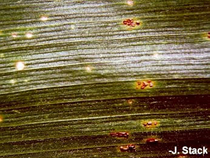
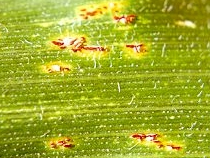
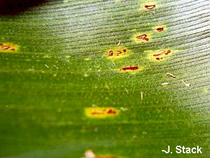
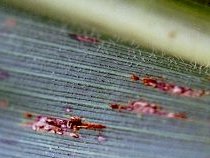
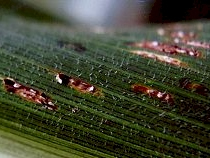
Favorable Environmental Conditions
Cool temperatures (60-80° F) and high humidity favor disease development.
Management
Genetic Resistance
Resistant varieties are the most cost-effective means to manage common rust. Consult your seed dealer to determine the best hybrids and inbreds for your area.
Cultural Practices
Since the pathogen does not survive in Nebraska, cultivation and crop rotation do not affect common rust development.
Links
For additional information, see the UNL Extension NebGuide, Rust Diseases of Corn in Nebraska (G1680).








